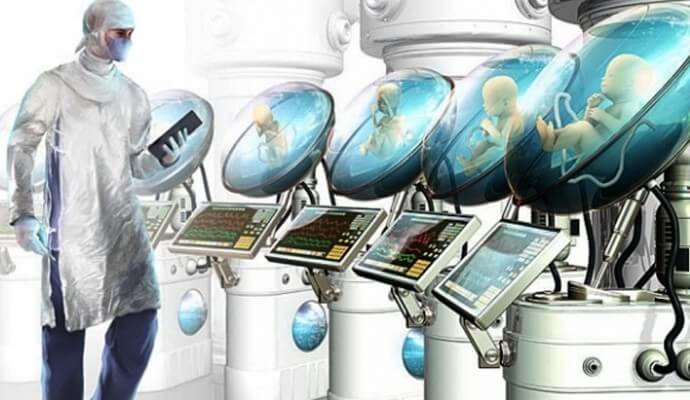I know. This looks pretty freaky, but what you’re looking at is actually a monumental step forward for medicine.
我知道。这东西看着就让人瘆得慌,但你看到的实际上是里程碑式的一次医学进步。
Researchers have now created an artificial womb that can successfully keep an extremely premature fetus alive and developing normally.
研究人员已经创建出了可以成功地让极度早产的胎儿存活下来并正常发育的人造子宫。
A lamb fetus, that is.
那里面的东西其实是一个羊胎。
The latest development in artificial placenta-based life support technology is an update to something called the ‘ex vivo uterine environment’ or EVE.
基于胎盘的人工生命支持技术取得的最新进展是“体外子宫环境”(简称EVE)的升级。
It’s a bag that acts as an external womb, providing all the physical support an animal would receive in utero.
而EVE就是一个能够充当体外子宫,为动物胚胎提供在子宫内获得的所有物质支持的袋子。
The hope is that it could provide a more natural—and therefore also more successful—alternative to the incubator,
研究人员希望,它能更接近原装——继而也更成功——地替代恒温箱,
that standard clear plastic box used to hold babies in healthcare environments like neonatal intensive care units.
就是那种统一的,在新生儿重症监护病房等医疗环境中安置婴儿的透明塑料盒子。
See, a typical pregnancy lasts about 40 weeks,
要知道,一个典型的孕期的持续时间是40周左右,
and any baby born before the 37 week mark is considered premature.
而任何发育时间在37周以内的婴儿都是所谓的早产儿。
Babies are technically able to survive outside the womb at about 21-24 weeks,
确切来讲,婴儿在子宫外能存活的时间为21~24周左右,
but that’s the extreme edge of viability, those babies are considered extremely premature.
但这已经是胎儿成活力的极限了,这些婴儿也都是所谓的极端早产儿。
And there’s a reason that one of the leading causes of death in newborns is being born prematurely—
早产成为新生儿死亡的主要原因之一是有原因的——
babies are really hard to keep alive outside the womb before a certain stage in their development.
婴儿在发育到一定阶段之前很难在子宫外成活。
Even with the advances in healthcare we’ve seen throughout the last several decades,
即便过去几十年里我们的医疗水平已经有了很大的进步,
like artificial airways and better ways to administer IV fluids to infants,
比如有了人工气道,给婴儿静脉注射的方式也有了提升,
infant mortality for babies born before 28 weeks remains as high as 50%.
但在28周前出生的婴儿的死亡率仍然高达50%。
And for babies born on or before the edge of viability about 24 weeks gestation, mortality after premature birth is even higher.
发育时间在24周左右这一成活力门槛之内的婴儿的早产死亡率甚至更高。
Those who do survive premature birth are likely to still suffer from life-long disabilities
即便从早产中幸存了下来,那些婴儿也可能还要承受终身残疾,
or chronic health conditions as a result of stunted organ development,
或由于器官发育不良导致的慢性健康状况带来的痛苦,
so it makes sense that we’re looking for a better way to keep babies alive and healthier when really, they should still be in the womb.
所以,研究让本应该还在子宫里(却已经出生了)的婴儿活得更好,更健康的办法是有道理的。
One of the main barriers to a successful artificial womb, which has been the subject of study for over 50 years,
人造子宫这个课题已经被研究了50多年,影响其成功的一个主要障碍就是
is that babies in utero are surrounded by amniotic fluid.
胎儿在子宫里是被羊水包围的。

That’s why their lungs don’t work properly before 37 weeks,
正因为如此,在发育到第37周之前,它们的肺都不能正常工作,
and instead of breathing, they benefit from a complex shared circulatory system—
那段期间它们并不会呼吸,维持发育靠的是一个复杂的共享循环系统——
they’re attached by their umbilical cord and the placenta to their mother,
通过脐带和胎盘与母体相连形成的系统,
whose own heart function keeps blood flowing between the two,
母体自身的心脏能够维持血液在两者之间的流动,
keeping the fetus oxygenated and taking carbon dioxide away.
持续为胎儿输送氧气并带走二氧化碳。
Which is why helping premature babies ‘breathe’ outside the womb is such a struggle.
也正因为这样,协助早产儿在子宫外进行“呼吸”才会变得如此困难。
Existing pumps that keep gases flowing through the baby’s body present the problem of damaging its heart—
现有水平下的那些将气体输送到婴儿身体各处的泵都会伤到婴儿的心脏——
one of the many challenges in healthcare for premature babies.
早产儿医疗也因此多了一重挑战。
So successful artificial wombs, like EVE, take inspiration from nature—
所以,诸如EVE之类的成功的人造子宫就要从天然的子宫上汲取灵感——
they look like a transparent, pillow-shaped plastic bag, filled with sterile artificial amniotic fluid that gets cycled out, gets filtered, and gets cycled back in.
把它们做成透明的,枕头形状的塑料袋,里面装满无菌的人工羊水,而那些羊水会被循环出塑料袋进行过滤然后再循环进塑料袋。
It relies on a novel, gentle oxygenator that uses just the fetal heartbeat to create successful circulation without causing any damage.
这一人造子宫依靠的是一种新颖而温和的氧合器,而这种氧合器靠胎儿的心跳就能成功地循环,不会对胎儿造成任何损害。
The fetus receives essential amino acids via IV to replace the nutrients that would normally be provided by the mother’s body,
胎儿可通过静脉注射获取必需的氨基酸,替代正常情况下需要母体提供的营养,
and antibiotics, also via IV, to protect it from infection the way its mother’s immune system would.
再通过静脉注射获取抗生素,像母体的免疫系统一样保护胎儿免受感染。
Basically: we’ve discovered that there’s no beating the original,
我们发现,基本上,原版都是无法被超越的,
so we have to design something that’s as close as possible.
所以,我们的设计只能尽可能地接近原版。
A team in 2017 kept premature lamb fetuses alive and developing normally for up to four weeks in an artificial womb,
2017年,某研究小组就让早产的羊胎存活下来,并在人造子宫中正常发育了四周之久,
and in 2019 a joint research team between the University of Western Australia and Tohoku University Hospital in Japan
2019年,西澳大利亚大学和日本东北大学医院组建了一个联合研究小组,
successfully kept extremely pre-term lamb fetuses—at the equivalent of 24 weeks of human gestation—alive for an unprecedented 120 hours.
成功地将极度早产的羊胎(相当于人类妊娠24周)的存活时间提高到了空前的120小时。
The lambs even continued to develop wool, just as they would have normally in utero.
小羊羔甚至还长出了羊毛,就像在子宫里发育一样。
You may be wondering why scientists are using lamb fetuses.
你可能会好奇,科学家们为什么要用羊胎。
Sheep are actually a commonly-used model organism when you study prenatal development
在产前发育研究方面,羊实际上是一种常用的模式生物,
because they go through many of the same processes in the womb as human babies,
因为它们在子宫中会经历许多和人类婴儿一样的过程,
but they also grow faster than the typical nine months,
而且,它们的生长速度也比人类怀胎一般所需的9个月时间要快,
so we can study the same stages and mechanisms of development, but at a slightly faster pace.
所以,我们不仅可以用羊胎来研究相同的发育阶段和发育机制,还能以更快的速度进行研究。
If this artificial womb stuff is sounding science fiction-y to you,
如果你觉得人造子宫听起来有些科幻,
it’s important to remember that we shouldn’t get ahead of ourselves:
但不要高兴得太早:
I mean for starters this artificial womb has only been tested so far on sheep, and only on already developing fetuses.
首先,到目前为止,这种人造子宫还只在羊身上,准确地说是已经发育了一段时间的羊胎身上进行了测试。
To grow a whole animal from scratch—that is, from an embryo—is an entirely different story and something we’re quite far off from achieving.
从头开始,也就是从胚胎开始培育出一只动物就要另当别论了,这方面可以说是路漫漫其修远兮。
But hopefully, this technology isn’t too far away from being implemented with premature human babies,
但这项科技还是有望在不久的将来应用到早产儿身上,
improving outcomes for preemies and their families all over the world.
去改善世界各地早产儿及其家庭的状况。












